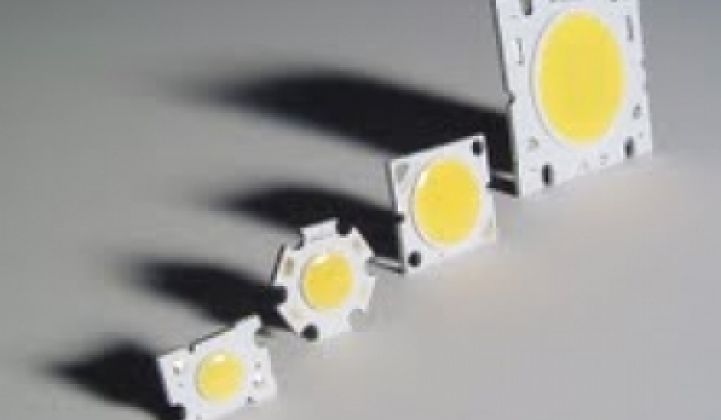Bridgelux is trying to put LEDs wherever it can.
The company last year came out with LED arrays -- essentially groups of LEDs that can share common components to reduce overall costs for the general lighting market. This year, the company has come up with refined versions of those arrays for specific markets.
The RS Array Series, for instance, are designed to replace the metal lamps and high-wattage fluorescent bulbs seen in hotel lobbies and retail outlets. This task is not as easy as it sounds: the light has to carry a long way and is often called on to illuminate large swaths of a store's floor.
"Metal halides are the highest-quality light source. Conventional LEDs cannot put enough light in a small space to replace them," said Bridgelux president Mark Swoboda. "These light sources have every bit of the oomph to create enough light. They can pretty much duplicate what the high intensity discharge lights can do."
The ES and LS series, meanwhile, are geared toward replacing conventional compact fluorescents and incandescents. Bridgelux does not make complete bulbs or lamps. Instead, it provides the LEDs and all the electronics in an integrated package that others can assemble into a final product. Expect announcements in a few months that will try to increase the interoperability of LED components with the existing lighting industry.
"The light market is used to a socket and a bulb," said Swoboda.
Although it has been promised for years, the solid state lighting revolution finally appears to be close at hand. For one thing, policy will dictate it: incandescents are already being phased out in Australia and the EU; Canada, the U.S. and others will follow with similar regulations that take effect from now through 2014.
Technology plays a role, too. High-end LED lamps have dropped 30 to 60 percent in price from a year ago, Swoboda said. The lower price, combined with the fact that LEDs require far less maintenance and energy, are making the economic argument attractive. Ideally, LED bulbs will cost around $25 in one to two years. (Today, a 60-watt equivalent can cost $40 or more.) Because the lights save around $15 in yearly electricity costs, demand is expected to escalate. The video here shows one of the first Bridgelux arrays.
Who will make it in LEDs? It's hard to say at this point. Bridgelux is currently raising $50 million for a new factory and recently appointed ex-Seagate head Bill Watkins to serve as CEO. The company's light arrays do cut the price of LEDs, and in general, Bridgelux is fairly well regarded. Other start-ups to watch include Luminus Devices (large, bright LEDs), Lunera (sideways LEDs) Renaissance Lighting (fancy fixtures) and D.Light Design.
The challenge, however, is that multinationals with deep pockets -- General Electric, Philips, Osram, TSMC, Toshiba, Panasonic, Sharp, to name a few -- also want to dominate the market. Expect an orgy of acquisitions and consolidation within a few years.
But LEDs aren't the only light technology coming to market. Luxim yesterday announced it has created a street light around its plasma light bulb that it says can save $145 per fixture. Luxim's bulb is about the size of a Tic Tac, but it emanates about the same amount of light as a spotlight. The light is generated by intensely focusing energy on a small chamber of gases. Luxim originally marketed the bulb to the projection TV industry, but that effort eventually died out. More info can be found in this video I created a few years ago.



